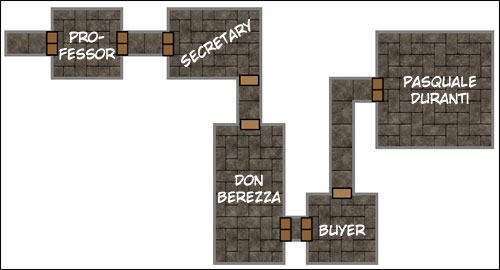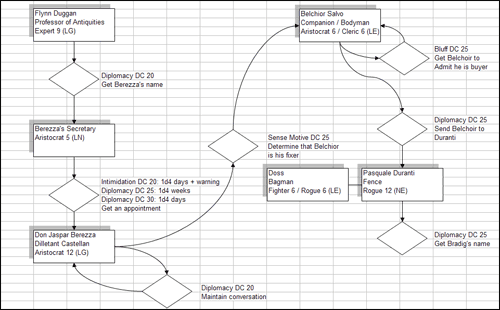The Dungeon Master’s Guide presents some very clear guidelines for the use of experience points as a reward mechanism for overcoming obstacles during an adventure. This is universally-understood to include combat encounters, but is also intended to include puzzles, riddles, traps, and social interactions. This is all well and good, and even the most inexperienced DM quickly learns how to plan for traps and combat, mapping out a dungeon, ruin, castle, village, or forest in which such obstacles are placed, and handling their presentation as a tactical matter. Where does this leave you when the obstacles that need to be overcome are the attitudes of a group of people that are all roughly in the same place?
Enter the social dungeon map. By treating an individual as a room in a cavern complex, and different approaches to interacting with the individual as means of progressing to the next step in a desired series of events, a DM can create a simple reference chart from which to fairly adjudicate a given series of social encounters without breaking the
flow of role-play too much.

In this example, the adventuring party is seeking out the source of a particular artifact. The person that lets the party know about the item does not personally know where it came from, or even who originally retrieved it. This presents the problem of tracing back through the chain of possession to somebody that has the information the party needs. This can be thought of as a series of rooms, each having a passageway to the next room. At the last room, the desired information is available to the party.
This is lovely for thinking out how the a given series of social challenges may progress, but doesn’t make for that good of a cheat-sheet for play. Enter the flow-chart:

Each conceptual “room” (in this case a series of NPCs) is connected to each other by some skill check. This isn’t the actual cheat-sheet I used (which was hand-written on a legal pad), but looks better on a screen. Information missing here are modifiers for some expected problems or alternate tactics. What if they decide to bribe Don Berezza’s personal secretary? Add a +2 bribery bonus per 500gp of value in the bribe. What if they try to physically intimidate the poor old professor? Use a lower base DC, but the Professor sends warning to the Don, increasing the difficulty of future checks with the Secretary, the Don, and his bodyman by +5 each, and so forth.
I generally don’t run games with a huge social aspect to them. Sure, there are interactions with the various NPCs. Normally I use them to present plot hooks (employers, damsels-in-distress, etc.), to gift the party with course-correcting advice, and as a source of equipment. This is somewhat of a test of my own ability as an adjudicator, as well as my play-group’s interest in this kind of challenge. Depending on how it worked out, in hindsight, additional challenges of this sort will fit in nicely with the campaign I’m currenly running.
Interesting approach. I remember the games my buds and I used to play had a big social aspect to them. I remember our DM using a somewhat similar idea for mapping out a series of encounters with NPCs, as well as other players. The latter was usually the most fun, when the DM would take aside individual players and allow them to be privy to certain story points beyong the knowledge of the other players. Subsiquent encounters between the players proved to be entertaining. Good times…
Looking at the rules for a system like Dungeons & Dragons can lead to some pretty bad assumptions about the form that a game should take. The rules revolve around finding things that are cleverly hidden, crafting items, and slaying monsters. Very little in the rules pertain to social interaction, with skills like Bluff and Diplomacy being relatively recent additions. This isn’t because characters shouldn’t interact with each other socially; the great majority of rules are present to deal with the non-role-playing portion of some adventurous story.
That said, nothing makes a scene exciting like a little danger, and combat introduces danger in a tidy, easily-presented way. I generally try to make sure every game session has at least one fight, my current campaign being a notable exception.